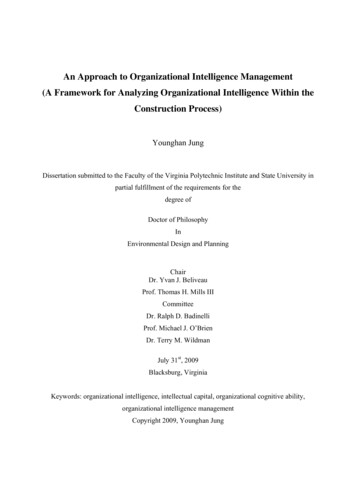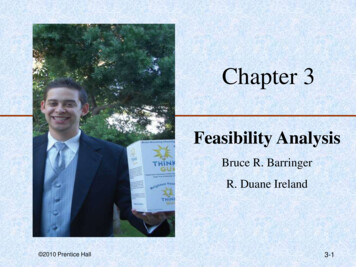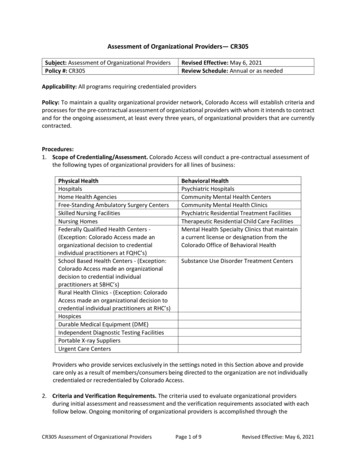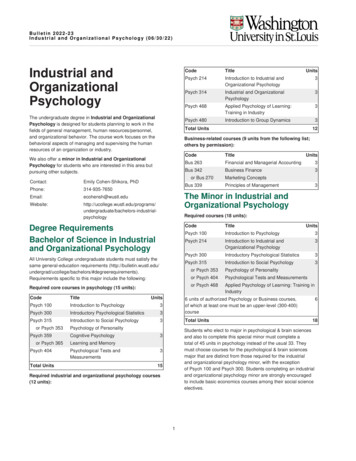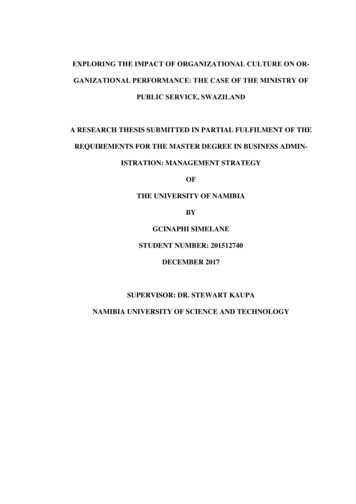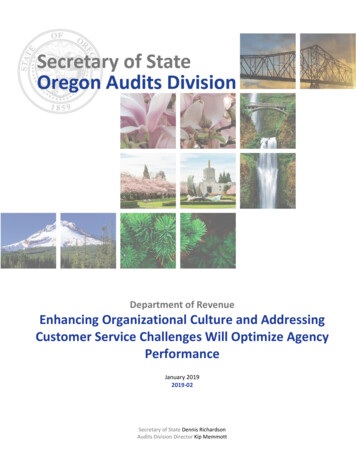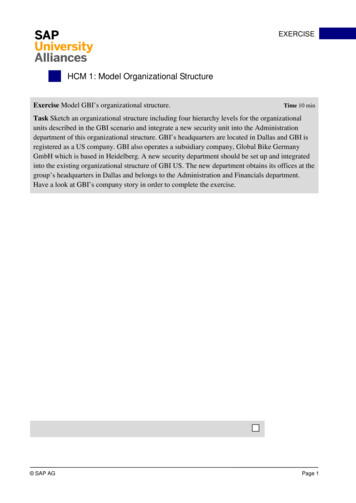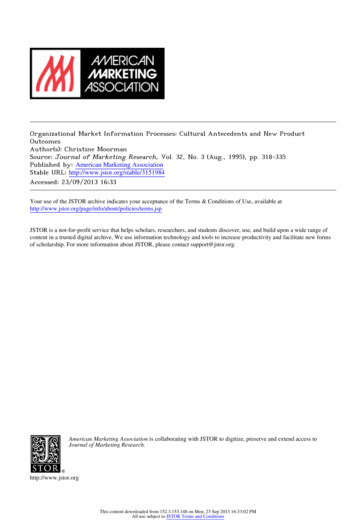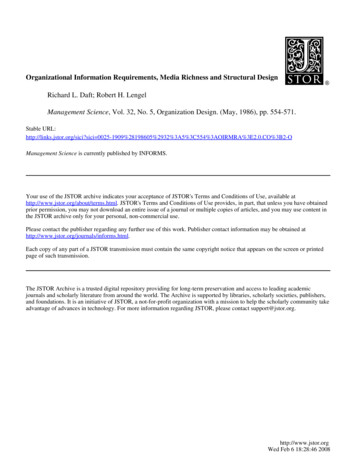
Transcription
Organizational Information Requirements, Media Richness and Structural DesignRichard L. Daft; Robert H. LengelManagement Science, Vol. 32, No. 5, Organization Design. (May, 1986), pp. 554-571.Stable URL:http://links.jstor.org/sici?sici O%3B2-OManagement Science is currently published by INFORMS.Your use of the JSTOR archive indicates your acceptance of JSTOR's Terms and Conditions of Use, available athttp://www.jstor.org/about/terms.html. JSTOR's Terms and Conditions of Use provides, in part, that unless you have obtainedprior permission, you may not download an entire issue of a journal or multiple copies of articles, and you may use content inthe JSTOR archive only for your personal, non-commercial use.Please contact the publisher regarding any further use of this work. Publisher contact information may be obtained athttp://www.jstor.org/journals/informs.html.Each copy of any part of a JSTOR transmission must contain the same copyright notice that appears on the screen or printedpage of such transmission.The JSTOR Archive is a trusted digital repository providing for long-term preservation and access to leading academicjournals and scholarly literature from around the world. The Archive is supported by libraries, scholarly societies, publishers,and foundations. It is an initiative of JSTOR, a not-for-profit organization with a mission to help the scholarly community takeadvantage of advances in technology. For more information regarding JSTOR, please contact support@jstor.org.http://www.jstor.orgWed Feb 6 18:28:46 2008
MANAGEMENT SCIENCEVol. 32, No. 5, May 1986Prinred in U.S.AORGANIZATIONAL INFORMATION REQUIREMENTS,MEDIA RICHNESS AND STRUCTURAL DESIGN*RICHARD L. DAFT AND ROBERT H. LENGELDepartment of Management, Texas A & M University, College Station, Texas 77843Department of Management and Marketing, University of Texas,San Antonio, Texas 78285This paper answers the question, "Why do organizations process information?'Uncertaintyand equivocality are defined as two forces that influence information processing in organizations. Organization structure and internal systems determine both the amount and richness ofinformation provided to managers. Models are proposed that show how organizations can bedesigned to meet the information needs of technology, interdepartmental relations, and theenvironment. One implication for managers is that a major problem is lack of clarity, not lackof data. The models indicate how organizations can be designed to provide informationmechanisms to both reduce uncertainty and resolve equivocality.(INFORMATION IN ORGANIZATIONS; STRUCTURAL DESIGN; ORGANIZATIONSTRUCTURE)1. IntroductionWhy do organizations process information? The answer most often given in theliterature is that organizations process information to reduce uncertainty. This line ofreasoning began when Galbraith (1973) integrated the work of Burns and Stalker(1961), Woodward (1965), Hall (1962), and Lawrence and Lorsch (1967) in terms ofinformation processing. Galbraith explained the observed variations in organizationalform based upon the amount of information needed to reduce task related uncertaintyand thereby attain an acceptable level of performance.Galbraith (1973), (1977) proposed that specific structural characteristics and behaviors would be associated with information requirements, and a line of research andtheorizing has provided support for this relationship. Studies by Tushman (1978),(1979), Van de Ven and Ferry (1980), Daft and Macintosh (1981), and Randolph(1978) support a positive relationship between task variety and the amount of information processed within work units. Van de Ven, Delbecq, and Koenig (1976) found thatdepartmental communication increased as interdependence among participants increased. A number of other studies have found that either the amount or nature ofinformation processing is associated with task uncertainty (Meissner 1969; Gaston1972; Bavelas 1950; Leavitt 1951; Becker and Nicholas 1969).Why do organizations process information? The organizational literature also suggests a second, more tentative answer: to reduce equivocality. This answer is based onWeick's (1979) argument that equivocality reduction is a basic reason for organizing.Equivocality seems similar to uncertainty, but with a twist. Equivocality presumes amessy, unclear field. An information stimulus may have several interpretations. Newdata may be confusing, and may even increase uncertainty. New data may not resolveanything when equivocality is high. Managers will talk things over, and ultimatelyenact a solution. Managers reduce equivocality by defining or creating an answerrather than by learning the answer from the collection of additional data (Weick 1979).*Accepted by Arie Y. Lewin; received October 1, 1984. This paper has been with the authors 5f monthsfor 1 revision.5540025-1909/86/3205/0554 01.25Copyr ght0 1986,The Institute of Management Sciences
ORGANIZATIONAL INFORMATION REQUIREMENTS555Emerging research suggests that equivocality is indeed related to information processing. Daft and Macintosh (1981) found that equivocal data were preferred forambiguous tasks, and managers used experience to interpret these cues. Putnam andSorenson (1982) found that subjects used more rule statements and pooled diverseinterpretations for equivocal than for unequivocal messages. Kreps (1980) reportedthat equivocal issues stimulated frequent communication feedback cycles in facultysenate meetings. Lengel and Daft (1984) reported that face-to-face media werepreferred for messages containing equivocality, while written media were used forunequivocal messages. These findings suggest that when equivocality is high, organizations allow for rapid information cycles among managers, typically face-to-face, andprescribe fewer rules for interpretation (Weick 1979; Daft and Weick 1984).Why do organizations process information? The literature on organization theorythus suggests two answers-to reduce uncertainty and to reduce equivocality. Whilethese answers are different, in some respects they are also similar. Both answers saysomething about information processing, about how organizations and managersshould behave in the face of these circumstances. Both answers have implications forthe type of structure an organization should adopt to meet its information processingrequirements to attain an acceptable level of performance (Lewin and Minton 1986).The purpose of this paper is to integrate the equivocality and uncertainty perspectives on information processing. One purpose of organizational research and theorybuilding is to understand and predict the structure that is appropriate for a specificsituation (Schoonhoven 1981). The concept of information processing provides auseful tool with which to explain organizational design. The prevalent view in organization theory has been that organization design enables additional data processing toreduce uncertainty (Galbraith 1973, 1977; Tushman 1978; Tushman and Nadler1978). This idea is important and is integrated with Weick's ideas about designing theorganization to reduce equivocality through means other than obtaining more data.Specific organization structures are recommended depending on the extent of uncertainty and equivocality faced by the organization from its technology, departmentalinterdependence, and environment.2. Background and AssumptionsOur approach to the study of organizations is based on several assumptions aboutorganizations and information processing. The most basic assumption is that organizations are open social systems that must process information (Mackenzie 1984), buthave limited capacity. Information is processed to accomplish internal tasks, tocoordinate diverse activities, and to interpret the external environment. Human socialsystems are more complex than lower level machine or biological systems (Boulding1956; Pondy and Mitroff 1979). Many issues are fuzzy and ill-defined. The interpretation of data cannot be fixed or routinized as in lower level systems (Cohen, March andOlsen 1972; Weick 1976). Despite the information complexity facing organizations,they have boundaries on their information capacity (March and Simon 1958; Simon1960; Cyert and March 1963). All available information to interpret the world cannotbe processed. Managers try to find decision rules, information sources, and structuraldesigns that provide adequate understanding to cope with uncertainty. One challengefacing organizations is to develop information processing mechanisms capable ofcoping with variety, uncertainty, coordination, and an unclear environment.The second assumption pertains to level of analysis in organizations. Individualhuman beings send and receive data in organizations, yet organizational informationprocessing is more than what occurs by individuals (Hedberg 1981; Daft and Weick
556RICHARD L. DAFT AND ROBERT H . LENGEL1984). One distinguishing feature of organizational information processing is sharing.An individual decision maker may interpret data in response to a problem (Simon1960; Ungson, Braunstein, and Hall 1981). Information processing at the organizationlevel, however, typically involves several managers who converge on a similar interpretation. Another distinguishing feature of organization information processing is theneed to cope with diversity not typical of an isolated individual. Decisions arefrequently made by groups so a coalition is needed. But coalition members may havedifferent interpretations of the same event, may be pursuing different organizationalpriorities or goals, and hence may be in conflict with respect to data interpretation orits significance for goal attainment (Ungson et al. 1981). Information processing at theorganization level must bridge disagreement and diversity quite distinct from theinformation activities of isolated individuals.The final assumption is that organization level information processing is influencedby the organizational division of labor (Burton and Obel 1980). Organizations aredivided into subgroups or departments. Each department utilizes a specific technologythat may differ from other departments (Hall 1962; Van de Ven and Delbecq 1974;Daft and Macintosh 1981; Daft 1986). For the organization to perform well, eachdepartment must perform its task, and the tasks must be coordinated with one another.Uncertainty and equivocality may arise from departmental technology, from coordination of departments to manage interdependence, or from the external environment(Tushman and Nadler 1978).3. Two Information ContingenciesUncertaintyBased on early work in psychology (Miller and Frick 1949; Shannon and Weaver1949; Garner 1962), uncertainty has come to mean the absence of information. Asinformation increases, uncertainty decreases. Uncertainty can be illustrated by atypical laboratory experiment. Laboratory subjects might play the game of 20 questions, wherein they receive yes-no answers to questions about the identity of anunknown object, which can be animal, vegetable or mineral (Bendig 1953; Taylor andFaust 1952). The "information" obtained from each answer can be precisely calculatedas the increased probability that the subject can identify the object. Improvement inidentifying the object is a reduction in uncertainty. When the person identifies theobject correctly, uncertainty is gone so additional questions provide no additionalinformation.The definition of uncertainty as the absence of information persists in organizationtheory today (Tushman and Nadler 1978; Downey and Slocum 1975). Galbraithdefined uncertainty as "the difference between the amount of information required toperform the task and the amount of information already possessed by the organization" (Galbraith 1977). Organizations that face high uncertainty have to ask a largenumber of questions and to acquire more information to learn the answers. Theimportant assumption underlying this approach, perhaps originating in the psychologylaboratory, is that the organization and its managers work in an environment wherequestions can be asked and answers obtained. New data can be acquired so that tasksare performed under a reduced level of uncertainty.EquivocalityEquivocality means ambiguity, the existence of multiple and conflicting interpretations about an organizational situation (Weick 1979; Daft and Macintosh 1981). Highequivocality means confusion and lack of understanding. Equivocality means thatasking a yes-no question is not feasible. Participants are not certain about what
ORGANIZATIONAL INFORMATION REQUIREMENTS557questions to ask, and if questions are posed, the situation is ill-defined to the pointwhere a clear answer will not be forthcoming (March and Olson 1976). For example,Mintzberg et al. (1976) examined 25 organizational decisions, and in many cases didnot find the type of uncertainty where alternatives could be defined and informationobtained. They found instead decision making under ambiguity where almost nothingwas given or easily determined. Managers had to define and figure things out forthemselves. Little data could be obtained. Uncertainty as studied in the psychologylaboratory did not characterize the ambiguity experienced by managers. A laboratorysituation analogous to the ambiguity faced by managers would be to provide subjectswith partial or contradictory instructions for the experimental game, or to leave it tosubjects to figure out and create their own game.Two ForcesThus we propose that two complementary forces exist in organizations that influence information processing. One force is defined as uncertainty and is reflected in theabsence of answers to explicit questions as has been studied in laboratory settings; theother force is defined as equivocality and originates from ambiguity and confusion asoften seen in the messy, paradoxical world of organizational decision making. The twoforces are analogous to an n-dimensional information space (Marschak and Radner1972; Baligh and Burton 1981). Uncertainty is a measure of the organization'signorance of a value for a variable in the space. Equivocality is a measure of theorganization's ignorance of whether a variable exists in the space. When uncertainty islow, the organization has data that answer questions about variables in the space.When equivocality is low, the organization has defined which questions to ask bydefining variables into the space. Each force has value for explaining informationprocessing behavior, and each force leads to different behavioral outcomes. Equivocality leads to the exchange of existing views among managers to define problems andresolve conflicts through the enactment of a shared interpretation that can directfuture activities. Uncertainty leads to the acquisition of objective information aboutthe world to answer specific questions.4. Integrating FrameworkThe two causes of information processing are combined into a single framework inFigure 1. The horizontal axis in Figure 1 represents organizational uncertainty. Underconditions of high uncertainty, the organization acquires data to answer a variety ofHigh2. High Equivocality, High Uncertainty1. High Equivocality, Low UncertaintyOccasional ambiguous, unclear events,managers define questions, developcommon grammar, gather opinions.Many ambiguous, unclear events,managers define questions, also seekanswers, gather objective data andexchange opinions.EQUIVOCALITY3. Low Equivocality, Low UncertaintyIIClear, well-defined situation, managersneed few answers, gather routineobjective data.4. Low Equivocality, High Uncertainty((Many, well-defined problems, managersask many questions, seek explicitanswers, gather new, quantitative data.IILowLowUNCERTAINTYHighFIGURE1. Hypothesized Framework of Equivocality and Uncertainty on Information Requirements.
558RICHARD L. DAFT A N D ROBERT H. LENGELobjective questions to solve known problems. The vertical axis in Figure 1 representsequivocality. Under conditions of high equivocality, managers exchange opinions toclarify ambiguities, define problems, and reach agreement. As a framework foranalysis and discussion, equivocality and uncertainty are treated as independentconstructs in Figure 1 although they are undoubtedly related in the real world. Highlevels of equivocality may require some new data as well as clarification and agreement. Circumstances that demand new data may also generate some need for additional interpretation and definition. However, as independent constructs the twodimensions in Figure 1 provide theoretical categories that can help explain both theamount and form of information processing in organizations.Cell 1. This cell is typified by a stream of only a few events that are equivocal andpoorly understood. Managers encounter occasional situations for which they may notknow what questions to ask or what problem to solve. Managers rely on judgment andexperience to interpret these events. They exchange views to enact a common perception. Answers are obtained through subjective opinions rather than from objectivedata. One example would be the feasibility of acquiring Corporation X. Would it fitstrategically and organizationally and accomplish the desired outcomes? No oneknows; no data can say for sure. Managers can only discuss this equivocal issue untilthey define whether a problem exists and that acquiring Corporation X is theirsolution. Goal setting is another example. Managers from engineering, marketing, andproduction may disagree about goal emphasis for the company, and no outside datawill resolve this issue. Approaches to resolve Cell 1 equivocality are the Delphitechnique (Delbecq, Van de Ven, and Gustafson 1975) and dialectical inquiry (Mitroffand Emshoff 1979). These techniques arrange for the exchange or even clash ofsubjective opinions when no objective data are available to predict an event orformulate strategy. Through the process of formally exchanging information, a common grammar and judgment evolves, equivocality is reduced, and a common perspective emerges.Cell 4. This cell represents a situation where uncertainty is high. The equivocalityof events confronting managers is low, but managers need additional informationabout many issues. They know what questions to ask and the source of external data.For example, if turnover among clerical employees is increasing, managers mightconduct a survey of reasons for leaving. If the question pertains to the reaction ofcustomers to certain product colors and labels, a special study may provide the answer.If inventory outages cause customer alienation, data about customer ordering patternsmay lead to an algorithm for inventory management. Information processing in thissituation involves data acquisition and systematic analysis. Cell 4 uncertainty represents the absence of explicit information. The organization is motivated to acquire andprocess data to answer important questions.Cell 2. Both equivocality and uncertainty are high in Cell 2. Many issues arepoorly understood and participants may be in disagreement. Issues also may beamenable to the gathering of new data that may influence managers' interpretation ofevents. A special study might be undertaken to gather data that can be combined withdiscussion and managerial judgment to reduce both equivocality and uncertainty. ACell 2 situation would probably be characterized by rapid change, unanalyzabletechnology, unpredictable shocks, and trial and error learning (Daft and Weick 1984).Cell 2 could occur during times of rapid technological development, within emergingindustries, or during the launching of new products. Some answers can be obtainedthrough rational data collection, and other answers require subjective experience,judgment, discussion, and enactment.Cell 3. A Cell 3 situation represents a low level of both equivocality and uncertainty. New problems do not arise with sufficient frequency to require significant
ORGANIZATIONAL INFORMATION REQUIREMENTS559additional data. Issues are well understood, so extensive discussion is not required toresolve and clarify issues. An organization in this situation would tend to rely on astanding body of standards, procedures, policies, and precedents. Routine schedules,reports, and statistical data would be the primary information base used by theorganization. A Cell 3 situation is typified by an organization that uses a routinetechnology in a stable environment.Figure 1 represents an attempt to combine the concepts of equivocality anduncertainty into a single framework. The quadrants in Figure 1 represent patterns ofproblems and issues that influence organizational information responses and ultimately the structural design of the organization. Structure can be designed to facilitateequivocality reduction, or to provide data to reduce uncertainty, or both, depending onorganizational needs.5. Structuring OrganizationsWe have argued that information processing in organizations is conceptually morethan simply obtaining data to reduce uncertainty; it also involves interpreting equivocal situations. The next question is how can organizations be designed to meet theneeds for uncertainty and/or equivocality reduction. Organization structure is theallocation of tasks and responsibilities to individuals and groups within the organization, and the design of systems to ensure effective communication and integration ofeffort (Child 1977). Organization structure and internal systems facilitate interactionsand communications for the coordination and control of organizational activities.Previous work by Galbraith (1973) and Tushman and Nadler (1978) has shown howorganization structure and support systems can be tailored to provide the correctamount of information to reduce uncertainty. We propose to take this line ofreasoning one step farther by arguing that organizational design can provide information of suitable richness to reduce equivocality as well as provide sufficient data toreduce uncertainty.Amount of InformationWith respect to uncertainty, structural design can facilitate the amount of information needed for management coordination and control. For example, Galbraith (1973)described how formal management information systems have greater capacity to carryuseful data to managers than do standing rules and procedures. Formal systems canprovide data about variables such as production work flow, employee absenteeism,productivity, and down time, and they can provide systematic data about the externalenvironment and competition (Parsons 1983). Other structural mechanisms includetask forces and liaison roles. A task force can provide a greater amount of informationwithin an organization than can a single face-to-face meeting. Liaison personnel canactively exchange data between divisions to reduce uncertainty. A number of studieshave indicated that information processing increases or decreases depending on thecomplexity or variety of the organization's task (Tushman 1978, 1979; Daft andMacintosh 1981; Bavelas 1950; Leavitt 1951). Specific structural mechanisms can beimplemented by the organization to facilitate the amount of information needed tocope with uncertainty and achieve desired task performance.Richness of InformationWith respect to reducing equivocality, structural mechanisms have to enable debate,clarification, and enactment more than simply provide large amounts of data. Managers work under conditions of bounded rationality and time constraints. The keyfactor in equivocality reduction is the extent to which structural mechanisms facilitate
560RICHARD L. DAFT AND ROBERT H. LENGELthe processing of rich information (Daft and Lengel 1984; Lengel and Daft 1984).Information richness is defined as the ability of information to change understandingwithin a time interval. Communication transactions that can overcome differentframes of reference or clarify ambiguous issues to change understanding in a timelymanner are considered rich. Communications that require a long time to enableunderstanding or that cannot overcome different perspectives are lower in richness. Ina sense, richness pertains to the learning capacity of a communication.Communication media vary in the capacity to process rich information (Lengel andDaft 1984). In order of decreasing richness, the media classifications are (1) face-toface, (2) telephone, (3) personal documents such as letters or memos, (4) impersonalwritten documents, and (5) numeric documents. The reason for richness differencesinclude the medium's capacity for immediate feedback, the number of cues andchannels utilized, personalization, and language variety (Daft and Wiginton 1979).Face-to-face is the richest medium because it provides immediate feedback so thatinterpretation can be checked. Face-to-face also provides multiple cues via bodylanguage and tone of voice, and message content is expressed in natural language.Rich media facilitate equivocality reduction by enabling managers to overcomedifferent frames of reference and by providing the capacity to process complex,subjective messages (Lengel and Daft 1984). Media of low richness process fewer cuesand restrict feedback, and are less appropriate for resolving equivocal issues. However,an important point is that media of low richness are effective for processing wellunderstood messages and standard data.Structural characteristics that facilitate the use of rich media are different fromcharacteristics that facilitate a large amount of data. Rich media are personal andinvolve face-to-face contact between managers, while media of lower richness areimpersonal and rely on rules, forms, procedures, or data bases. For example, Van deVen, Delbecq, and Koenig (1976) found that coordination mechanisms varied along acontinuum from group, personal, to impersonal. When task nonroutineness or interdependence were high, information processing shifted from impersonal rules to personalexchanges including face-to-face and group meetings. Lengel and Daft (1984) foundthat rich communications were used by managers for difficult and equivocal messages.Rich information transactions allowed for rapid feedback and multiple cues so thatmanagers can converge on a common interpretation. When messages were unequivocal, media such as written memos or formal reports were sufficient to meet informationneeds. Finally, Daft and Macintosh (1981) found that qualitative, face-to-face techniques were preferred in equivocal situations.Structural CharacteristicsTaken together, these ideas and findings begin to suggest how organizations handledual information needs for uncertainty and equivocality reduction, for both obtainingobjective data and exchanging subjective views. We propose that seven structuralmechanisms fit along a continuum with respect to their relative capacity for reducinguncertainty or for resolving equivocality for decision makers. This continuum isillustrated in Figure 2. The continuum reflects the relative contribution of designcharacteristics for uncertainty reduction and equivocality resolution, and suggests thatstructural mechanisms may also address both needs simultaneously.1. Group Meetings. Group meetings include teams, task forces, and committees(Galbraith 1973; Van de Ven et al. 1976). Project and matrix forms of structure utilizefrequent group meetings as a means of coordination. The comparative advantage ofgroup meetings is equivocality reduction rather than data processing. Participantsexchange opinions, perceptions and judgments face-to-face. Some new data areprocessed, but the advantage of group meetings is the capacity to reach a collective
ORGANIZATIONAL INFORMATION REQUIREMENTSIIStructure facilitates e s s i c h , w e r s o a li'IStructure facilitates c h per&, i aaIIAIl S niF 0 dInformaionspedalMrect&UpEqurVOCALEY REUImCN(Clarify, reach agreanent,decide a c h questians to ask.)U N W mm C N(Obtain d i t i o d data, seekansuers to explicit questions .)FIGURE2. Information Role of Structural Characteristics for Reducing Equivocality or Uncertainty.judgment. Through discussion, a cross-section of managers from different departmentsreach a common frame of reference (Weick 1979). Managers can converge on themeaning of equivocal cues, and are able to enact or define a solution. The strength ofgroup meetings is the ability to overcome differences and to build understanding andagreement. Group discussion is a subjective process rather than the collection of harddata for rational analysis.2. Integrators. Integrators represent the assignment of an organizational position toa boundary spanning activity within the organization. Full-time integrators includeproduct managers and brand managers (Galbraith 1973; Lawrence and Lorsch 1967).Part-time integrators include liaison personnel whose responsibility is to carry information across departments, such as might be done by a manufacturing engineer(Galbraith 1973; Reynolds and Johnson 1982). The integrator role includes thetransmission of data, but it is primarily a way to overcome disagreement and therebyreduce equivocality about goals, the interpretation of issues, or a course of action(Lawrence and Lorsch 1967). When managers approach a problem from diverseframes of reference, equivocality is high. Integrators and boundary spanners useface-to-face and telephone meetings to resolve these differences.3. Direct Contact. Direct contact represents the simplest form of personal information processing. When a problem occurs, Manager A can contact Manager B for abrief discussion, such as how to get production back on schedule (Galbraith 1977).Direct contact can occur laterally among departments or vertically between hierarchical levels. Direct contact often uses rich media, thus is similar to group meetings andintegrator roles, although written memos and letters also are used. Direct contactallows managers to exchange views and disagr
Based on early work in psychology (Miller and Frick 1949; Shannon and Weaver 1949; Garner 1962), uncertainty has come to mean the absence of information. As information increases, uncertainty decreases. Uncertainty can be illustrated by a typical laboratory experiment. Laboratory subjects might play the game of 20 ques-



